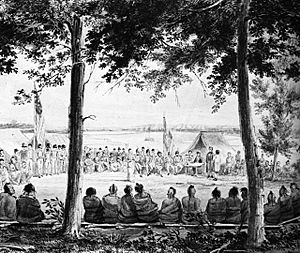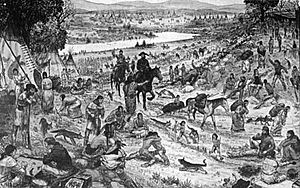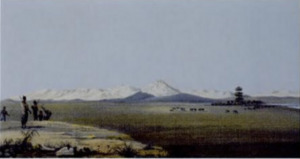Joseph Bijeau facts for kids

Joseph Bijeau (born 1778, died after 1837) was an early fur trapper in the Rocky Mountains. He was also known as Joseph Bijeau dit Bissonet or Joseph Bissonet. In 1820, he guided Stephen Harriman Long's group across the Great Plains. Joseph Bijeau was a skilled fur trapper and hunter who lived among the Pawnee people. He could talk to many Native American tribes using Plains Indian Sign Language and the Crow language. After Spain lost control of the land that is now New Mexico, trappers like Bijeau moved to Taos. There, they could trap animals, trade furs, and travel east more safely.
Contents
Joseph Bijeau's Early Life
Joseph Bissonet was born on June 15, 1778, in St. Louis. At that time, St. Louis was part of a large area called the British America. His parents were Louis Bissonette and Genevieve. His father traded with the Little Osage people. Joseph later took the last name of his stepfather, becoming Joseph Bijeau. He was of French Canadian background.
St. Louis was started in 1764 as a fur trading post. It was in a great spot where the Missouri River and Mississippi River meet. This land was originally home to many Native American tribes, including the Illini Confederacy.
Joseph Bijeau had a brother named Louis Bissonet (born 1774, died around 1836). Louis was also a trader along the upper Missouri River. The Bijou Hills in South Dakota are named after Louis. He set up a trading post there in 1812.
A Skilled Trapper and Hunter

Joseph Bijeau started working as a fur trapper in 1806. By 1812, he was part of the fur trade with Manuel Lisa. Around 1814, he worked for a fur trapping company in St. Louis, Missouri. He joined the Chouteau-de Mun group of fur traders who traveled into the southwest in 1815. He went into the wild areas of what is now Colorado to trap beavers and hunt buffalo. The animal furs were traded at posts along the Front Range and then sent east.
He traveled deep into the Rocky Mountains, where there were many beavers. He knew a lot about the trails in the Rocky Mountains. He knew paths as far north as Yellowstone and as far south as Santa Fe. Other famous frontiersmen he knew included Kit Carson.
Between 1815 and 1817, Spanish soldiers arrested 21 trappers for entering Spanish lands. Joseph Bijeau was one of them. He was taken to Santé Fé and held in prison for 48 days. After that, he went back to St. Louis.
Joseph Bijeau knew the Crow and sign language. This meant many Native American tribes could understand him. Sign language was used by Native Americans because they spoke so many different languages. The Crow language was also known by many western tribes. In 1820, he lived with the Pawnee people.
The Stephen H. Long Expedition
Major Stephen Harriman Long led a government trip to explore the Great Plains. This journey went along the Missouri River in Nebraska, up to the Rocky Mountains in Colorado, and then east across Indian Territory (which is now Oklahoma). The expedition split into two groups. Joseph Bijeau was a guide and interpreter for the group led by Captain John R. Bell. This group traveled down the Arkansas River and towards the Rocky Mountains.
Captain Bell's group included Lieutenant Swift, Samuel Seymore, five soldiers, and guides Bijeau, Deloux, and Julien. Bijeau was considered the most important guide. This was because he had hunted and lived in the region for many years.
Joseph Bijeau hunted, prepared, and cooked food for the expedition. He also helped take care of the men and animals. He was described as "faithful, active, hardworking, and talkative." He shared many stories about his adventures in the Rocky Mountain area. Because of their skilled guides and Bell's good diplomacy, the expedition had no problems with the Native Americans they met. Bijeau shared his knowledge of the Rocky Mountains. He explained that some peaks were too high to reach and had snow all year. He also said that rivers and streams flowed through wide valleys.
On June 30, 1820, they first saw the Rocky Mountains near what is now Bijou Creek in Fort Morgan. Long named the creek Bijeaus Creek after his helpful guide.
We saw a blue strip, close to the horizon in the west. Some thought it was just a cloud, but others said it was the Rocky Mountains.
—Captain John Bell, who wrote about the Long Expedition
The group traveled south along the Front Range, following the South Platte River. They went up Pikes Peak and visited the Manitou Mineral Springs. Then they headed east again along the Arkansas River. Bijeau and Ledoux traveled with them for part of the way east. Then, they returned to their homes with the Pawnee on the Loup River in what is now Nebraska.
Trapping in Taos
Spain lost control of the area that is now New Mexico in 1821. This area became popular for trappers. They could easily and safely travel the Santa Fe Trail back east to the United States. Also, there were no hostile Native Americans in the area. The Spanish empire was no longer worried about trappers. In the 1820s, Joseph Bijeau and other trappers moved to Taos, which was then part of the First Mexican Empire. Bijeau moved there in 1824. He asked to become a citizen in 1830. He trapped with Ceran St. Vrain and Bernard Pratte during the winter of 1827–1828. He lived in Taos in 1836 and 1837.


